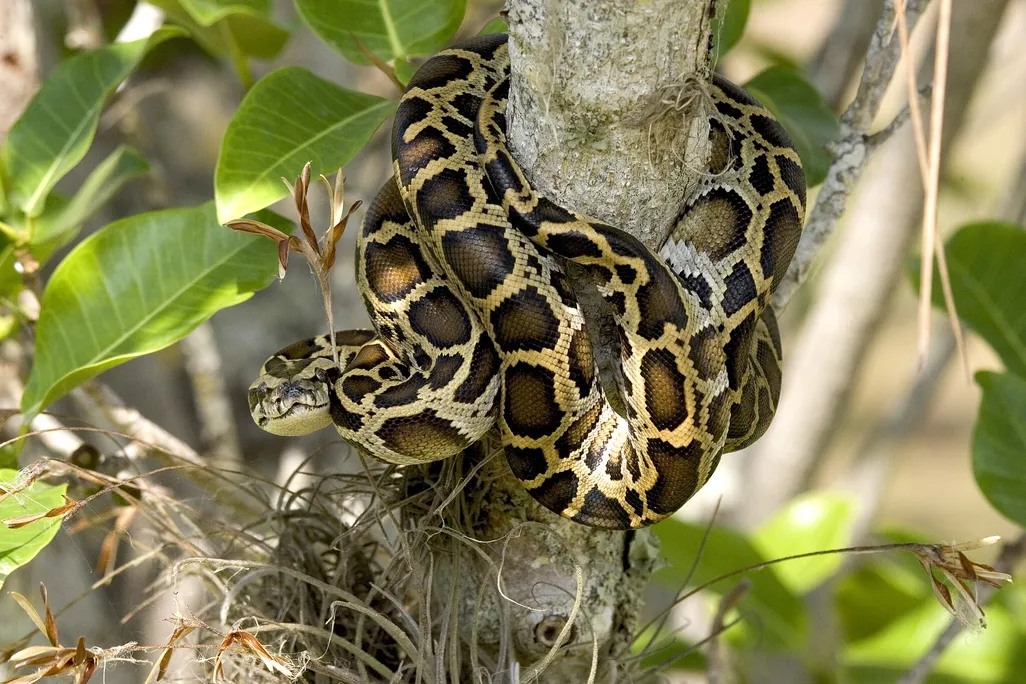Researchers Discover the Trick That Allows Burmese Pythons to Digest the Bones of Their Prey
Special intestinal cells collect excess minerals into particles the snakes can poop out, according to a new study

Burmese pythons—one of the longest snakes in the world—have interesting eating habits. As opportunistic feeders, they wait for a prey animal to stray a little too close before gripping it with their jaws, wrapping their bodies around the unfortunate creature and squeezing until it suffocates. Then, the snakes swallow the prey whole, sometimes downing shockingly large animals thanks to the stretchy connective tissue between their cranium and lower jaw. Then, they might wait weeks—or even months—before their next meal.
Unlike owls, which regurgitate pellets of indigestible material such as bones and teeth, Burmese pythons fully dissolve the skeletons of their prey. Researchers describe the cellular mechanism behind this strange ability in a study published in late June in the Journal of Experimental Biology. The work was presented on July 9 at the Society for Experimental Biology Annual Conference in Belgium.
Need to know: Burmese pythons as an invasive species
- In Florida, Burmese pythons are highly invasive. In just a few decades, they have decimated local Everglades species like racoons, marsh rabbits, opossums, foxes and bobcats.
- Human hunters and some native creatures can kill pythons as a way to combat the snakes.
Burmese pythons need a consistent source of calcium, so they need to eat some bones. Too much calcium, however, can be poisonous, as Michael Cove, a conservation biologist at the North Carolina Museum of Natural Sciences who did not participate in the research, tells Science News’ Bethany Brookshire.
“We wanted to identify how they were able to process and limit this huge absorption of calcium through the intestinal wall,” study lead author Jehan-Hervé Lignot, a biologist at the University of Montpellier in France, explains in a statement.
The team studied Burmese pythons’ enterocytes, or cells that line the inside of intestines, as well as their blood calcium and hormone levels. Their investigation revealed a previously unknown cell type along the snake’s intestine. These cells are narrow and have short microvilli, finger-like protrusions on the surface of some cells. They also feature a cup-shaped, internal “crypt”—and inside, the researchers found large sphere-like particles of calcium, phosphorus and iron that Lignot had never seen in other vertebrates.
“When I started analyzing the ‘spheroids’ I initially thought it could be some bone fragments. But this rapidly proved to be wrong,” Lignot tells Popular Science’s Andrew Paul. “Then came the hypothesis that the particles could be produced by the intestine and by a specific cell type.”
To further analyze these findings, Lignot and his colleagues fed captive Burmese pythons three different types of diets: one low-calcium diet with boneless prey and two calcium-rich diets—one with whole rodents and one with boneless rodents and calcium injections. Other snakes fasted the whole time for comparison.
While the snakes on the boneless prey diet did not produce the newly identified particles, the snakes on the calcium-rich diets did, ultimately expelling the “spheroids” in their feces.
“Therefore, Burmese pythons possess a specialized intestinal cell type involved in excreting excess dissolved calcium and phosphorus that originate from the prey and are precipitated as particles that must accumulate in the feces,” the researchers write in the study.
They also found the specialized cell in other snakes, as well as the venomous Gila monster lizard. Other researchers have seen similar particles in invertebrates, like crustaceans and insects, but this new identification marks the first time a related system was found in vertebrates, per Popular Science.
This system might even be present in non-reptiles that eat bones. In fact, Lignot tells Gizmodo’s Ellyn Lapointe that he hopes the study will stimulate a search for it in other animals.
/https://tf-cmsv2-smithsonianmag-media.s3.amazonaws.com/accounts/headshot/Margherita_Bassi.png)
